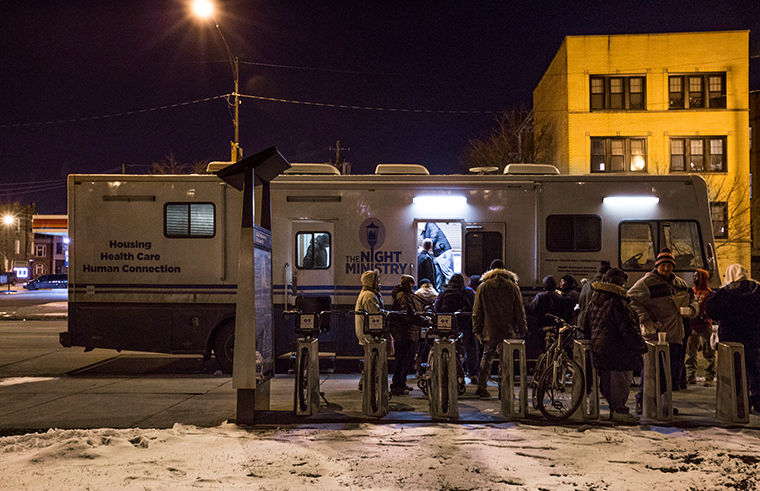Shelters heat up while Chicago cools down
The Health Outreach Bus tours different locations six days a week to provide basic medical needs for those who may not have access to health care.
February 19, 2018
After cold spells and heavy snowfall, Chicagoans bundled up and headed indoors to avoid the winter freeze, but not everyone had a warm place to call home.
Chicago experienced nine straight days of snow Feb. 3-11, following a cold blast in early January that struck the central and eastern U.S. and caused an estimated 22 deaths, according to the Weather Channel.
These inclement conditions could put the estimated 82,212 homeless people in Chicago at risk, according to a 2015 Chicago Coalition for the Homeless report.
“I’ve seen over the years some really bad cases of frostbite,” said A. Ann Holcomb, supportive services supervisor for Unity Parenting and Counseling, a group that runs the Ujima Village Shelter. “I physically had to cut off the glove from [a] person’s hand [because the glove froze] to their skin. [The weather is] a pretty big problem [for the homeless].”
Depending on the weather conditions, frostbite can develop more quickly than most people would think, said Bobby Watts, CEO of National Healthcare for the Homeless Council.
Some people are subjected to cold conditions all night and lack proper protection, and homeless shelters are the last line of defense, Holcomb said.
Night Ministry operates a homeless shelter named The Crib, 835 W. Addison Ave., and also provides a health bus that operates six days a week with a nurse practitioner to provide free basic health care and screenings, said Burke Patten, senior communications associate.
“We can prevent something much worse from happening down the road,” Patten said. “[We could] prevent an infection from spreading or getting worse. Sometimes, we are able to prevent visits to the emergency room.”
Shelters are generally open at night—the standard operating hours of the Ujima Shelter and the Crib. These hours have been extended in the past when inclement weather strikes, according to Patten and Holcomb.
The Ujima Village Shelter is able to stay open and provide services 24/7 thanks to city funding, which is usually provided during inclement weather conditions, Holcomb said. Even at times when the city was not able to provide funding, some of the shelter’s volunteers stepped up to keep it running, she added.
The Crib also received city funding to help the shelter stay open during cold snaps in late December and early January as well as during the recent snowfall, Patten said.
Along with extended operating hours and more beds, these shelters can also provide clothing for the homeless, according to Patten and Holcomb.
Both Ujima Village and the Crib accept donations of winter clothing, such as gloves, socks and coats, and were as prepared as possible for the upcoming snowfall and winter conditions, according to Patten and Holcomb. While neither shelter reported a shortage of items to provide, the shelters could always use more clothing, Holcomb said.
“We are dependent on donations,” Holcomb said. “There is only so much we can prepare.”
Increased awareness about the conditions homeless individuals face can hopefully increase the public’s generosity, Patten said.
“The more education we are able to give to our donors and our potential supporters [the more] they find out our needs,” Patten said. “That can help us get the items that we need.”








